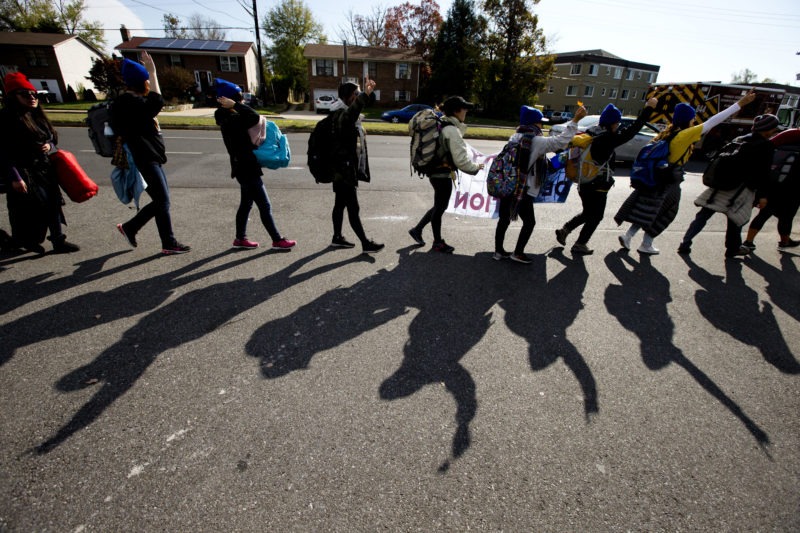Their future in US at stake, ‘Dreamers’ trek to Supreme Court
Dozens of young “Dreamer” migrants are seen walking through Langley Park, Maryland, en route to the US Supreme Court, where their fate will be decided (Jose Luis Magana)
Washington (AFP) – Carolina Fung Feng was resting after the grueling 230-mile walk from New York to Washington for a Supreme Court hearing Tuesday that will determine the fate of “Dreamers” like her — the 600,000 young migrants who arrived illegally in the country as children.
Only 12 years old when she arrived from Costa Rica, Fung Feng, now 30, has made her life in America.
But that life was plunged into limbo after President Donald Trump — who campaigned on a starkly anti-immigrant platform — moved in 2017 to end the Delayed Action for Childhood Arrivals (DACA) program that has given Fung Feng and others the legal cover to work and study in the US.
Together with dozens of other “Dreamers,” she had trudged southward for 16 days, braving rain, cold, and bruised and blistered feet. Shrugging off their exhaustion, the group broke into a jog as they finally neared the Supreme Court in Washington on Sunday, shouting, “Our home is here.”
Fung Feng is a plaintiff in a lawsuit that, while wending its way to the high court, has allowed DACA to remain provisionally in force.
“Through this march, we wanted to let people know that the program is in danger of being fully terminated and we want to remind them that we’re still here,” she said.
Being part of the suit — the Supreme Court is not expected to issue a ruling before 2020, the same year as a hotly contested presidential election — matters hugely to Fung Feng.
She feels she can be the voice for other young people in her situation, as well as the other 10.5 million undocumented migrants estimated to be in the country.
– ‘The same pain’ –
According to United States Citizenship and Immigration Services, there are 660,000 registered DACA beneficiaries, including 529,760 from Mexico and smaller numbers from El Salvador, Guatemala, Honduras, Peru, South Korea, Brazil and other countries.
While their experiences differ, Fung Feng said, “We all have the same pain.”
In the courtroom Tuesday, nine black-robed justices will weigh the Dreamers’s fate. Five of them are conservatives, including two appointed by Trump.
“I expect the judges to listen to our case, understand that we’re human beings,” Fung Feng said.
“And their decision could not just impact myself as an individual, but my family and my community as well.”
The DACA program was created in 2012 under President Barack Obama.
Antonio Alarcon, 25, is another Dreamer with much at stake. He arrived in the US from Mexico as a child.
He recalls the day he registered with DACA as when “I was recognized by the United States finally after living so many years in the shadows.”
In 2017, Trump gave Congress six months to devise a plan to replace DACA, saying he was sympathetic to the Dreamers but that Obama had established the program illegally.
But lawmakers were unable to reach agreement, and the program expired the following year.
The phase-out of the program has been appealed to several courts across the country, ultimately reaching the Supreme Court.
– ‘Amplify the message’ –
Alarcon has lived alone in New York since the age of 17, when his parents returned to Mexico.
While studying film and political science, he has been working as a community organizer.
He came to Washington, he said, to “amplify the message… that this is our home.”
If the Supreme Court fails to extend legal protection to the Dreamers, they are not expected to be automatically deported; most will probably slip quietly into the shadowy life of the undocumented, for whom working and studying is fraught with difficulty.
“I will change my lifestyle,” said Alarcon. “But I don’t think I will change the way that I provide for my community.
“Our family members are still undocumented, and they still survive,” he said. “Our parents have shown us how to be warriors.”
Silvia Garcia arrived in the US from Argentina in 2002 and decided to stay. She and her husband live in New York state. Neither is documented.
For her, the walk from New York required considerable sacrifice: the factory where she has worked for 10 years would not give her time off, so she had to quit, but she said it was worth it to come represent her 19-year-old son.
“It’s a lot of difficulty,” she sighed. “We have a lot of blisters, we had cold showers — really raining hard — and I twisted my ankle.”
Still, she has no regrets.
“It’s a lot of things, but we made it. We did 230 miles.”
Disclaimer: Validity of the above story is for 7 Days from original date of publishing. Source: AFP.


